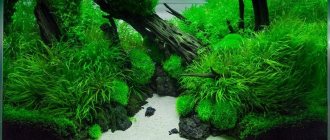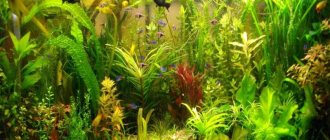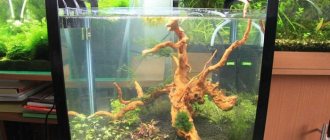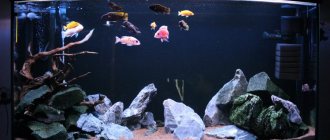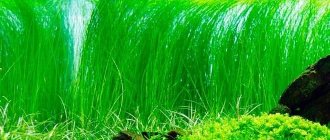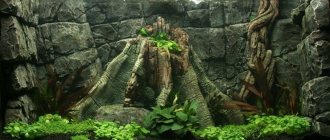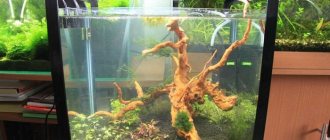The Iwagumi style of aquascaping comes from Japanese gardening traditions using stone structures - an example is the well-known “rock gardens”. Accordingly, the basis for designing an aquarium in this style are several large stones or fragments of rocks, selected and placed in a strictly defined manner. Each of them has its own name and purpose, which go back to the Japanese philosophical perception of nature. It is very difficult for a simple layman with a European mindset, such as the author of this article, to understand the deep meaning of Iwagumi, so the emphasis will be on its key features and how it differs from other styles of aquascaping.
The classic version of the exhibition involves the presence of three stones, partially covered with dense growth of low-growing plants, forming a kind of carpet that extends further across the entire ground. Fish are given a secondary role, and are often completely absent. It is worth noting that in modern iwagumi aquariums more than 3 stones are used, but their number is always odd.
Description of Iwagumi stones
As mentioned above, a certain number of stones are used in this style. In this case, a description of three +1 will be given. What is “+1” is also a separate stone with its own name and purpose, but it never stands alone and is not taken into account as an independent design element.
Oyaishi
Usually, this is the largest stone and the basis of the entire structure. Oyaishi is always used as the centerpiece. It is located at an angle to the flow of water, as if it were in a river bed.
Fukuishi
It is the second largest stone in the aquarium. It should be similar in color and texture to Oyaishi. Traditionally placed to the left or right of the Oyaishi, it serves to create visual balance to the resulting stone display.
Soeishi
The third largest stone, its main purpose is to highlight the beauty of the first two stones.
Suteishi
The smallest stone serves to ensure balance and harmony of the entire structure. This is the same stone that is not singled out separately (+1). Unlike other stones, it is completely covered with plants and becomes almost invisible.
Iwagumi style aquascaping is sometimes called the simplest of other natural aquarium styles. One can hardly agree with such a statement. Creating an underwater landscape from stones and plants that would awaken in the mind a feeling of peace and harmony, akin to the feelings that arise when contemplating a living fire or floating clouds, is quite difficult and within the control of masters.
In articles devoted to natural aquariums, one can often find statements that the styles of this trend wonderfully reflect the chaotic nature of nature. Meanwhile, neither the creator of the natural aquarium T. Amano, nor his followers, who reached the pinnacle of this type of aquascape, seemed to have spoken anywhere about chaos; on the contrary, they in every possible way emphasized the harmony of wild nature and embodied it in their aquariums. Using the example of the Iwagumi style (decorating aquariums based on a composition of stones), we will show how correct the composition of stones is mathematically verified with harmony.
The first composition in the Iwagumi style was shown by aquascaper T. Amano in 1985.
This is what the first Iwagumi looked like, created by T. Amano - today a classic
T. Amano has repeatedly advised beginners, before starting to create an aquascape, to think very well about the future composition, taking into account all the elements, and to make a sketch of the future aquascape. Errors that appear after the aquarium is filled with water and the plants grow are almost impossible to correct - and a huge investment of time and labor will be wasted.
Essentially, the rocks in the Iwagumi aquascape act as the structure of the entire project.
Therefore, the implementation of the Iwagumi project begins with the selection of stones.
Classic recommendations for creating Iwagumi establish the principle of an odd number of stones used.
There is also a requirement - all stones must have the same structure and texture that matches the main stone. The master studies the chips of the main stone and selects subsequent stones so that the lines of their texture coincide and are parallel to those on the Oyaishi stone.
Using an odd number of stones prevents the human eye from separating the design down the center and creating unnatural symmetry.
T. Amano emphasized that symmetry is not characteristic of natural landscapes; it arises where a person fits into the landscape. An odd number of stones makes the process of creating a natural landscape easier (including for novice aquascapers), since creating symmetry from an odd number of elements is problematic. Thus, the odd number will give even beginners the opportunity to form a natural composition.
Experienced craftsmen create asymmetrical compositions from an even number of stones, but beginners are better off not taking risks.
The initial number of stones, the composition of which will embody the principles of Iwagumi, is considered equal to five. But the masters of this style make do with less. This, let's call it a substyle, Sanzon Iwagumi, consists of only three stones - a large main stone, a smaller second one, and the presence of auxiliary stones is also allowed.
Sanzon Iwagumi
Here, as an example, consider the creation of an Iwagumi composition from five stones.
Each stone has its own name.
- The main stone (in English literature the English alliteration of the Japanese name Oyaishi is used) is the largest stone of the composition. The height (of course, the height will determine other dimensions) should be 2/3 of the height of the aquarium. They always place it tilted to the side. The most successful compositions are those where the direction of the slope as well as the direction of the lines of the stone texture coincides with the direction of the flow in the aquarium. It was not possible to find an explanation for this fact in the literature, but it is quite likely that since the plants also bend in the direction of the flow, an additional visual diagonal is formed over time, adding harmony and dynamism.
- The first secondary stone (Fukuishi) - it can be installed either on the right or on the left
- The second auxiliary stone (Soeishi) - the task of this stone, located on the opposite side of the first secondary stone, is to emphasize the massiveness of the main stone, its dominant position in the composition and to visually balance the first auxiliary stone.
If you carefully study the Iwagumi masters, you can conclude that the top of one of the auxiliary stones is always lower than the top of the first auxiliary stone.
Let's take a closer look at how T. Amano arranged these stones in his composition.
— the height of the main stone is 2/3 of the height of the aquarium, it is located on the line cutting off 2/3 of the length of the aquarium;
- if you connect the vertices of the stones, we get a triangle with an aspect ratio that is a multiple of 1/3.
As you can see, the master places the stones not thoughtlessly, but in accordance with mathematical harmony - the principle of the golden ratio.
- Auxiliary stones (4) (Suteishi - Japanese translates as “thrown stone” or “thrown stone”, as you like) - used to create the impression of completeness of the composition and its completeness, they are located either in front of or behind the auxiliary stone. This miniature stone is not particularly noticeable at first glance, even covered with plants over time. However, it is said to enhance other parts of the garden, adding subtle complexity and spontaneity to the design.
Please note that in his composition T. Amano arranged the auxiliary stones so that their vertices formed an additional visual diagonal, almost parallel to the main visual diagonal, which is formed by the vertices of the main and first secondary stone.
This technique made it possible to visualize the principle of harmony in the dynamics of movement of frozen space, which was widely used by such Mannerist painters as El Greco.
By the way, pay attention - the height of the soil plus the height of the plants in the right and left corners of the aquarium are not the same, and also form a visual diagonal (yellow line) in the same direction as the main diagonals
Kotoak we see that all elements of the composition are geometrically verified and balanced.
It is thanks to the correctly formed balance that the atmosphere of calm and tranquility that is so seductive in natural aquariums, and in Iwagumi in particular, is created.
Compositionally well placed stones fulfill the common goal of natural aquariums - to create a balance between hardscape, open space and scale of each design element.
We can say that it is precisely for this reason that beginners who have not mastered the practical side of Iwagumi, which is achieved in the process of creating unsuccessful compositions as a reward for perseverance, rarely succeed in successful Iwagumi - after all, not only static stones, constantly growing plants, but also moving fish are involved in the overall balance .
And, nevertheless, even a beginner can create a beautiful Iwagumi - try to adhere to the requirement in forming a composition not to violate the rules of the two-thirds ratio and the rule of a triangle with a vertex that does not coincide with the lines dividing something into two equal parts (by the way, if you look closely at compositions by T. Amano - you can find two-thirds of the size of which are the fish he sometimes uses).
Among the plants in Iwagumi, the ones most often used by professionals are those with small leaves. Taller plants should be planted correctly in the background.
Eleocharis acicularis,
Eleocharis parvula,
Glossostigma elatinoides,
Hemianthus callitrichoides
Pogostemon helferi
These plants are used to soften the visual impact of rocks without obscuring the underlying structure. The low-growing greenery also gives the impression of forested land, with mountain-shaped center stones.
Growing individual seedlings (they are planted using special tweezers, such tweezers are available at aquaMegaMall.ru) can take considerable time, but once they grow, the harmonious final effect will be worth the effort. Plants grown in an Iwagumi aquascape typically require weekly pruning to maintain the compact carpet nature.
Small groups of shrimp and small schooling fish add additional touches of calm dynamism to the overall harmony of the landscape with their movement and also help fight algal growth.
Aquariums with stones in Japanese style. Video
A little summary
Creating a true Iwagumi style, which embodies the Japanese principles of simplicity and spirituality, is probably only possible for professionals. And the criteria for evaluating it are rather arbitrary and have a rather philosophical and sometimes even sacred meaning. If you set a goal for yourself to make just a similar aquarium for your home, then you should take into account the following possible difficulties that you will have to face.
The first problem is ensuring plant growth. Dense thickets and a dense root system require the introduction of special fertilizers and carbon dioxide. In addition, the challenge is to ensure sufficient and uniform illumination of the entire surface. Otherwise, some of the plants, especially in the corners, may not receive enough light and will stand out against the general green background. The second problem is algae, which is likely to take up residence in your planted aquarium. To remove them, you will have to use special preparations, or purchase special equipment that can effectively deal with them.
"Retro" from the 1930s
Dutch style is the oldest style, becoming popular in the 1930s in the Netherlands. The most important element in the formation of the underwater landscape in this direction of aquascape is vegetation.
For the masters of the “Dutch aquarium”, it is important to know how to properly plant, group and combine algae so that the completed composition looks attractive and unusual, reminiscent of an underwater garden or park with lawns, paths and intricately shaped bushes.
Underwater landscapes display such conceptual techniques as contrasting colors of components, the use of different textures of leaves and stems, construction of perspective, and layering.
The shape of the tanks of Dutch aquariums can be called traditional: with approximately equal width and height, and a length exceeding these parameters by at least three times. Another feature of the direction is connected with this - panoramic, that is, the side walls are closed, and only the front glass is intended for inspection, through which, like through a large window, you can admire the landscape.
Dutch aquarium
The most common technique used in the Dutch style is the formation of terraces. The complex arrangement and grouping of plants helps create a deep perspective in the aquarium, alternating components that complement each other in shape and color.
The technique of identifying focal points in space is effectively used. Usually the breakdown is done using red or large plants. More than 70% of the tank floor is planted.
Contrast is a key element of the Dutch aquarium style as it is important when it comes to breaking up this density. Plants are grown in groups and contrast is achieved through careful use of color variations, height and leaf texture.
Spaces between groups of plants create imaginary streets and paths, helping to gain a deeper perspective.
Advantages:
- looks attractive thanks to a system of color and texture contrasts;
- can be created without expensive stones, since the hardscape is hidden by vegetation.
Flaws:
- complex rules for creating a composition;
- you will have to buy a lot of algae of different types, take into account their characteristics and compatibility;
- requires constant care (pruning, fertilizer, light).
Is it difficult to create an aquarium with an aquascape?
Of course, creating an aquarium with a beautiful natural design underwater is somewhat more difficult than a regular one. To get a spectacular underwater landscape at home, in addition to the aquarium itself, you will have to purchase additional expensive equipment.
Also, difficulties may arise with finding and purchasing the necessary components for the soil, the plants themselves, driftwood, etc. Those who want to create an aquascape aquarium will most likely have to order all this via the Internet. And it won't be cheap.
Rosstandart: “Every tenth gas station deceives.” How to protect yourself from underfilling
Do you need to replace the tulle on your windows? Calculate its size
A giant “flying saucer” hovered over Bulgaria (photo)
Stages of creating an aquarium
Aquariums with a natural landscape are usually created in several stages. First, plants are selected for which the most suitable soil is selected - sandy, peat, large, small, etc. Any plants can be used in such an aquarium. In some cases, many species are planted in such aquariums, in others - no more than three or one.
Next, a suitable relief is selected and created - hills, depressions, channels, etc. Then additional elements are selected - stones, snags, etc.
When creating aquariums, aquascape lovers most often use the golden ratio principle in design.
When arranging the relief, they try to achieve the effect of maximum depth and volume of space. Stones are most often used in an odd number, as it is believed that it looks more harmonious.
Found a violation? Report content
